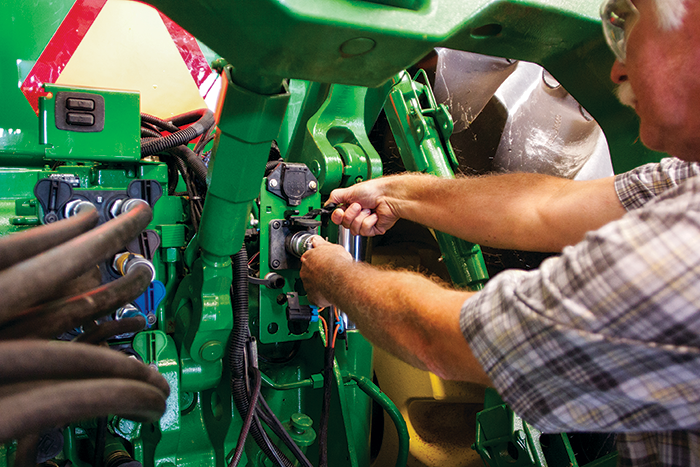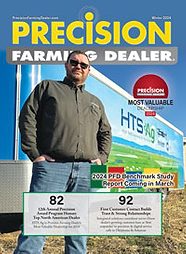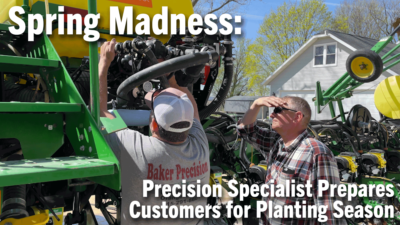Manufacturers like Kinze are working to simplify ISOBUS capabilities for farmers by improving “plug-and-play” functionality. Ideally, farmers won’t have to change monitors, displays, wiring harnesses or electrical connectors to run one brand of tractor with another brand of implement. Photo courtesy of Kinze Manufacturing
The likelihood that farmers have all the same color equipment planting, fertilizing and harvesting their land is increasingly remote.
Precision farming technology is giving growers more freedom to select equipment that best suits them — regardless of brand — and upping the ante for precision farming dealers to find compatibility solutions for customers.
At Western Sales Ltd., a John Deere dealership in Rosetown, Saskatchewan, precision farming specialist Greg Carlson routinely works on a rainbow of colors on customers’ farms.
“Only a small percentage of my customers have solid green equipment throughout their farm operations,” Carlson says. “There’s always at least one piece that’s isn’t, and it’s up to me to find a way to make it work with whatever else they’ve got.”
One emerging compatibility option is ISOBUS — a concept that allows farmers who are using precision technology to connect any brand of tractor with any implement without losing functionality and performance.
But the ability to seamlessly operate different colors of farm equipment together remains more of a promise than a solution for many precision ag dealers to offer customers.
“It’s been a stumbling block for years trying to get one color to electronically talk with another,” Carlson notes. “For dealers, it’s been like bringing someone to a party and they have nobody to talk to.”
However, the ISOBUS conversation is evolving as manufacturers develop products that can reduce compatibility headaches for precision specialists and improve efficiency for customers.
Seeing is Believing
Last fall, Western Sales tested an ISO system produced by Agtron Enterprises, based in Saskatoon, Saskatchewan, to run a Morris Industries Ltd. 2012 C2 Contour Air Drill with a Deere tractor.
The dealership began selling Morris air drills in 2011, but in order to get them to effectively communicate with the Deere GreenStar 3 2630 displays, customers needed to purchase an additional monitor for the tractor cab.
“We wanted to bring a commonality for customers and let them use what they’re used to,” Carlson says. “The goal is to offer one display in the tractor cab rather than a cockpit full of monitors.”
Agtron representatives did the initial installation — essentially a plug-and-play system into the back of the Deere tractor — and then Carlson monitored the Morris air drill’s functions through the GreenStar 3 2630 in the tractor cab.
But the real accuracy test came when Western Sales’ agronomists uploaded planting prescriptions through the Deere software to see if the Morris machine would respond to the variable-rate seeding plan.
“We could see the application was accurate and mapped out accordingly,” Carlson says. “I think that is where customers are going to see a lot of value.”

After the successful demonstration, Western Sales began to offer the Morris air drills installed with the Agtron ISO system, or as an aftermarket purchase.
While it’s too early to gauge the impact that the ISO product has had on sales, Carlson says the option will be a money-saver for customers and open the door for Western Sales to more successfully partner the Morris air drills with Deere tractors, without having to worry about compatibility problems.
“It’s just a more fluid sales procedure to be able to offer one product and say, ‘Mr. Customer, you don’t have to spend another $20,000 on another display and get it hooked up,’” Carlson explains. “This is big for us and certainly going to help sales, because farmers can pop that GreenStar into the tractor to run with the Morris and away they go. It’s simple.”
Djamel Khali, vice president of operations for Ally Precision Industries (API), in Sioux Falls, S.D., agrees that the flexibility ISO provides can be a significant money saver for farm customers.
API is one of several third-party manufacturers producing ISO-components designed to connect different colors of farm equipment. Khali recently installed an API ISOLynx system on a customer’s Versatile tractor to run his Deere planter.
“We put the whole system on there for under $15,000,” he says. “He saved the cost of having to buy a John Deere tractor to run the planter, and he could run it the same way with the tractor he already owned.”
But he and others acknowledge that the concept is far from perfect and hasn’t gained the same traction in North America as it has in Europe, where the ISO got its start.
Guarding Expectations
Part of the problem is a lack of knowledge and awareness about what ISOBUS is and how it works.
“I think part of the hesitation is that people just don’t understand the ISO concept,” says Bill Baker, president of Agtron Enterprises. “It’s going to be a pull-through market for dealers once farmers fully understand it.”
In it’s simplest form, ISO — which stands for International Standards Organization — allows farmers using precision technology to connect any brand of tractor with any implement without losing functionality.
Precision dealers and their customers wouldn’t have to switch monitors, displays, wiring harnesses or electrical connectors when they move from one implement to another.
“Farmers tell me all the time that they spend a day each spring putting all the monitors in the cab and mounting and running harnesses in and out,” Baker says. “ISO lessens that learning curve because they know that same tractor terminal will be in there 365 days a year.”
But ISOBUS is still only a buzzword in North America, since the ISO 11783 standard was introduced in tractors and implements in 2001, says Khali.
He notes that not every North American farm equipment manufacturer is on the same page when it comes to ISO.
Historically, if farmers had an ISO-certified tractor from the factory and an ISO-certified implement — but they weren’t the same color — certain features would be locked out because of compatibility issues.
“If we’re going back to the core goal of ISO — to be color agnostic — we need to make sure farmers are getting what they’re expecting,” Khali says. “Farmers might be losing row-shutoff or variable-rate planting capabilities. That’s where a lot of the frustration comes from today.”
The potential that farm customers won’t be able to visualize and manage their precision operations with ease is one sticking point precision farming dealers have with ISOBUS.
“The biggest thing is you are limiting what you can view when you are using the ISO and what you can view outside of the ISO structure at the same time,” says Aaron Hacker, precision ag specialist at Elite Ag Solutions in Warren, Ind. “For some customers, it’s not a big deal, but for others, it’s a non-starter. They aren’t even going to touch it if they can’t easily view everything at once.”
Last spring, Hacker connected a customer’s John Deere planter with another brand of tractor through a Trimble FmX Integrated Display and was able view some — but not all — of the farmer’s precision applications through the ISOBUS display.
To allow the customer to see and control all planter functions — outside of the ISO connection — took several additional hours.
“At this point, you could take an FmX display and spend an hour, put the cable in, hook the monitor up, get everything configured and it’s ready to go,” Hacker says. “But if you are doing all the planter control and everything through the FmX display outside of ISO, then you’ve got several hours worth of time and set-up.
“Doing that every year for a customer, an hour vs. 12 hours or whatever it would take, there is some significant cost associated with that.”
Playing Catch Up
Hacker says he isn’t on board with the ISOBUS concept yet, because he doesn’t want to mislead customers about its value and risk promising a solution he can’t deliver.

One of the goals of ISOBUS is to reduce clutter in the tractor cab by utilizing one display to monitor precision functions. Currently, farmers with different brands of farm equipment often need multiple monitors to be able to track all of their precision technology. Photo courtesy of Kinze Manufacturing
“I’ve cautioned customers not to just jump into this and get ourselves in a situation where we’re into planting season and something’s not working right,” he says. “If it’s an ISO compatibility issue, my hands are kind of tied on what I can do.”
The last thing precision dealers want is to give farmers a false assurance that ISO is the answer to all their compatibility problems because the term often means something different to each customer, notes Doug Prairie, product manager for planter, seeder and harvest controls for Raven Industries.
The challenge for manufacturers is to provide a level of ISO integration that truly allows customers to be able to get the most out of their technology. Some run proprietary software, which creates confusion about the compatibility ISO offers to farmers. This can muddy confidence in the technology.
“There is some electronic finger pointing that goes on in some cases,” Prairie says. “The tractor says the implement is to blame, and the implement says the tractor is to blame, and the customer is caught in between.”
This also puts precision farming specialists in a difficult position of trying to make different brands of farm machinery work together, when software components don’t communicate well.
The end result for some farmers is being able to utilize only a portion of their precision functions through their ISO connection, or being forced to add an extra monitor.
“I see some customer’s cabs where you can’t even see out because they have so many monitors,” says Lanty “Spud” Armstrong, precision farming specialist at Ag Technologies Inc. in Rochester, Ind. “I’d love to be able to get them down to one and for that reason, ISO needs to happen.
“But right now, because most companies’ ISO products won’t let farmers see everything, guys are still going to end up with an extra monitor in there to make it work.”
|
International Group Works Toward ISOBUS Adoption |
|---|
|
|
Manufacturers need to get on the same page and iron out the functionality wrinkles before broader adoption occurs, dealers say.
“The biggest downside is manufacturers don’t always want to help out if you have an issue,” says Jeremy Dasher, precision farming specialist at Archbold Equipment Co., a Case IH dealership in Archbold, Ohio. “It’s a matter of getting them together, so precision dealers aren’t behind the eight ball when we’re trying to work with ISO.”
Working Together
While there is an incentive for companies that produce both tractors and implements to have their brand of machinery running together on a farm — in conjunction with their precision-technology platform — they acknowledge the value of ISO standardization.
The Agricultural Industry Electronics Foundation (AEF), an independent international organization, is working with manufacturers to eliminate some of the ISO mystery for dealers and their customers. John Deere, Case IH and AGCO are three of more than 50 companies working with AEF to test and certify ISO components with the goal of creating a standardized platform.
More than ever, there’s a push by manufacturers to create a uniform ISO standard that will further simplify compatibility for dealers and their customers, says Trevor Mecham, marketing manager for Advanced Farming Systems (AFS) for Case IH.
“Farmers want a one-stop shop,” says Mecham, an AEF board member. “They don’t want something to have to be added on. The technology needs to be built-in and integrated, so if the farmer wants to make a change with his or her planter or tractor, they have the capability to run what they want together.”
Although the ISO standard was introduced in North America more than a decade ago, it’s potential is only just starting to be realized by dealers.
Dasher eased into the technology recently by working with a customer to set up Case IH’s AccuControl system on a John Deere 7200 series planter. By starting small, Dasher was able to deliver what the customer wanted.
“It was just simply for seed monitoring, but it worked out reasonably well,” he says. “We had a couple of glitches, but now he’s looking to add row clutches and start doing more operations.”
ISO’s Future
Increasing farm customer demand is pushing manufacturers to develop better ISO solutions for the future and compensate for compatibility shortcomings of the past.
“In the past, I think, ISO has been advertised for more than it was,” says Rhett Schildroth, product manager for Kinze Manufacturing. “The North American industry is now catching up with the original intent of ISO.”
In 2012, Kinze announced production of its ISOBUS line of planters, which will be available this spring. A component of its ISO system is a single monitor in the tractor cab that allows farmers to manage operations.
Case IH is developing its ISO Task Controller system, a module that will improve functionality and performance by electronically sending and receiving data between different brands of tractors and implements.
The system lets farmers plug into the ISO connector, and the task controller logs the work that’s been done, Mecham explains. Then those tasks can be created, displayed or exported via a USB stick and recorded.
“Part of the reason for moving forward with this technology is getting the customers up and running faster through improved software,” Mecham says. “How can we make it more seamless?”
One industry goal, Schildroth says, is to broaden the availability of automatic controls, where a farmer wouldn’t have to manually input seed-rate changes or import prescription maps. Currently, only a handful of tractors and implements support automatic control through ISO.
Kinze’s new line of ISOBUS planters will support the automated-control function, which means farmers can automatically view their prescription maps on the go and change their seeds rates without having to touch a button.
“I still think we’re one or two years out from that advanced functionality of working with any brand or make of tractor or implement,” Schildroth says. “But most manufacturers are working to get it there.”
This is promising news for precision dealers who have to provide a broader array of electronic compatibility solutions for customers.
The evolution of ISOBUS will give dealers the ability to not only retain, but attract new customers, notes Carlson.
“This has to do with how quickly customers are turning equipment over and if they are shopping around, they may not be loyal to anything. Then you are just chasing them,” he says. “With ISO, we will be able finish off deals we’ve been waiting on to provide customers with a complete compatibility package.”








Post a comment
Report Abusive Comment